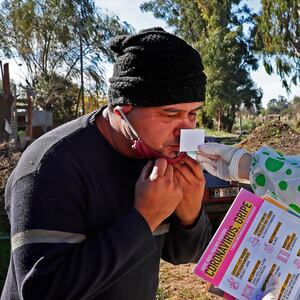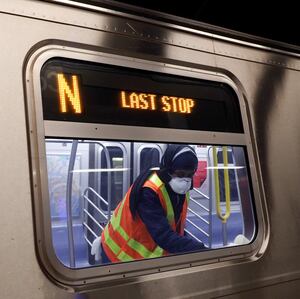Like many people who work full-time jobs, Danielle knows she is lucky. She’s able to work from home, and the 37-year-old says her current employer is much more accommodating of her disability than her previous. That said, there have been hurdles—like the fact that telecommuting software like Zoom and WebEx still does not allow captioning, which can make work calls stressful when you’re deaf.
“It’s a huge step back, when the internet should be a huge step forward,” Danielle told The Daily Beast in an email. “It concerns me that things are going to remain even more inaccessible in [the] future since a lot of things are switching to remote video options, and using platforms that do not have captioning.”
It’s no small irony that the Americans with Disabilities Act celebrated its 30th anniversary this year. Because like so many other emergencies before it, the COVID-19 pandemic has illustrated that in just about every possible situation people with disabilities are treated as an afterthought.
ADVERTISEMENT
Consider one of the most essential public health solutions to the pandemic: face masks. They’re undeniably important to prevent the spread of the novel coronavirus. But the masks most of us wear every day make communication difficult for Danielle and others who lip-read. At one point, Danielle noted, a pharmacist became angry with her for not being able to communicate. And others have been less than receptive when she asked if they could consider wearing clear face masks that would allow her to communicate better.
“When I politely requested that if they are able to, people consider wearing a clear face mask, I was told to suck it up and that's life, and that nobody would do that,” said Danielle, who requested her last name be withheld for privacy reasons.
Some elements of the pandemic, however, have made Danielle feel less isolated in her job. She does not, for instance, have to watch her co-workers chat amongst themselves, which she says has been a boon to her mental health.
In general, Danielle believes the U.S. response to the pandemic and the needs it presents for people with disabilities has been typical of the way it treats their concerns. That is to say, they’ve been ignored. People’s reluctance to consider clear face masks, and businesses like Zoom leaving captions out of their functionality, can add to a feeling that people with disabilities “don’t matter.”
“People will spend a lot of money ordering custom designed masks, while there are clear face masks available for the same price, but the message is that our needs are too ‘abnormal’ and that ultimately we don’t matter because we are out of the norm from the rest of society,” Danielle wrote.
For another example of how our response to COVID-19 has ignored people with disabilities’ needs, think for a moment about restaurants’ outdoor set-ups. They’ve proven controversial because of the crowds they generate and the sweltering conditions they create for service staff. But urban sidewalk set-ups that narrow pedestrian spaces can be a nuisance for anyone who uses mobility equipment. And some street seating does not provide ramps or leave sufficient space for people who use wheelchairs and other equipment—rendering them unusable for some.
Disability rights activist Emily Ladau, who also co-hosts The Accessible Stall Podcast, will be the first to tell you that these oversights are pretty much par for the course.
“I think that right now we're witnessing this very interesting dynamic where disabled people are not only an afterthought, but also kind of told that if we speak up about it, we are essentially just creating trouble,” Ladau told The Daily Beast. “And I think we’ve always been told that. This is not new, but... it's much more in the public eye now.”
Ladau noted the rash of non-disabled people last month who began presenting cards purporting to show that they could not wear face masks due to respiratory disorders. (Some people with disabilities genuinely cannot wear masks, but they didn’t seem to be the ones presenting those cards in the cases that got attention.)
“So any way you look at it, the ADA’s actual purpose and intent is just being completely thrown out the window right now,” Ladau said. “Either you have people telling us that we’re being complainers for trying to speak up about basic rights and access, or you have people… trying to exploit legislation that's not for them.”
“It is extremely disheartening to see able-bodied people use fake medical conditions or ‘disability’ as a way to get out of wearing masks,” Danielle wrote. “The overwhelming majority of the disabled community want everyone to be wearing masks, and wear masks themselves, because a portion of the disabled community is immunocompromised themselves.”
Much of the problem is an ongoing stigma—the idea that people with disabilities are isolated shut-ins, rather than members of the community with active social lives just like anyone else.
As Jean Ryan, president of Disabled In Action of Metropolitan NY, told The Daily Beast government officials and businesses tend to overlook people with disabilities’ interests because they can’t imagine a disabled person dining in a restaurant, celebrating events with family, or otherwise participating in society.
The results can range from frustrating to genuinely dangerous for people with disabilities.
Early on in the pandemic, COVID-19 strained a resource some people with disabilities depend on: shopping services like Instacart, which became overrun with customers who wanted to avoid shopping in person.
Given concerns about crowding and the number of non-disabled people with underlying conditions that put them at risk, too, it made sense. But it was people with disabilities with no other options who wound up paying the steepest price—a dynamic Ladau said “points to a larger access issue, because these things that disabled people use on a daily basis are often seen as laziness and a luxury.”
“So all of a sudden everybody needs them and now they’re in high demand, and ‘How dare you not have my toilet paper rolls available from Instacart?’” Ladau said.
And although most people with disabilities do not rely on personal care attendants to live independently, the pandemic provided a challenge from the start to those who need assistance.
As virologists and journalists rushed to figure out and communicate how the novel coronavirus actually spread, understandable anxiety grew among caregivers and their clients, Ryan said. Neither party could be sure how many people the other had been in contact with, putting both at risk for further exposure. Some caregivers were reluctant to continue working, either because they were elderly themselves or because they cared for grandchildren or other young dependents.
“If you need help with personal care, or with cooking, or getting groceries, or getting your clothes washed, your bed changed, any of those things, then you’re at somebody's mercy,” Ryan said. “And it could be a very loving, capable person, but you, you don't know.”
The fact that carriers can be asymptomatic only deepened fears, and Ryan knows of at least one person whose attendant died of the virus—leaving them with the difficult task of finding a new caregiver in the middle of a pandemic.
Making matters worse, in the early months of the pandemic, agencies often did not supply staff with enough, or any, personal protective equipment—effectively shifting the financial responsibility to caregivers or their clients.
And even after quarantine gave way to phased reopening, problems persisted.
Ryan, who normally does her own grocery shopping, has found she is not able to properly distance in stores while using her wheelchair. Even before COVID-19, it was impossible for her to reach all of the items she needs from high shelves—and now, anyone handing her an item they’ve retrieved must somehow give it to her from 6 feet away.
Rather than going inside, Ryan stays on the sidewalk outside the store and tries to get the attention of an employee, who then retrieves the items on her list and uses her credit card to pay for them before bringing everything to her outside.
“Of course, trust has to be involved in that,” Ryan said. “But how else are we going to get through this, if we don't trust each other?”
When it became safer to walk outside with a mask, Ladau—who lives just outside New York City—ventured out to see what conditions were like. The sidewalks were cluttered with people, tables, and chairs—a nuisance for the non-disabled, but a real disruption for people with disabilities who might use pre-planned accessible routes to go about their days.
For people who rely on such routes to navigate their neighborhoods, due to physical, visual, or other disabilities, “it can be really problematic [and even] scary” when those routes are changed, Marc Fliedner, director of Disability Rights New York’s Protection and Advocacy for Individual Rights and Protection and Advocacy for Individuals with Mental Illness programs, told The Daily Beast.
Without an alternative route planned, he said, “If there’s a new impediment in their way, what are they supposed to do to go around?”
Still, Ryan said, “I think we just really have to have tolerance because the restaurants are barely surviving and without indoor patrons… I think it will be temporary. It won’t last forever. And if we ever want to order from a restaurant or sit in a restaurant or sit outside of a restaurant, I think we all have to work together on that.”
Ladau, Ryan, and Fliedner all emphasized that they understand everyone is doing the best they can. But nonetheless, these lapses illustrate the ways accessibility is almost always treated as an afterthought. As Ladau put it, “It’s a symptom of a larger problem.”
Another challenge Fliedner has noticed is that the automated interfaces many businesses use—from cleaning services to ride-share apps—can make it difficult for people with disabilities who might need certain concessions to make arrangements beforehand. (While an actual human being might be able to understand a person’s needs and collaborate to find a solution, apps and automated phone lines usually cannot.) This can make it difficult for, say, someone who genuinely cannot wear a mask due to respiratory issues to access these services.
“I would encourage any business that has mandatory rules about these things to also somehow make… some opportunity available for individuals with unique circumstances to be able to reach out to a human being, to talk to them either by chat or by phone or by email exchange,” he said, to explore what accommodations might be possible.
Regardless of the details, the upshot in all these situations remains the same: The disabled community always seems to fall through the cracks as everyone “tries their best.” And the results can be harrowing.
Fliedner, for instance, still remembers the nightmare some people with disabilities faced during the emergency response to Hurricane Sandy.
“There were stories about people that were trapped on the 20th floor of a building, and the elevators weren't working,” Fliedner said. In 2013, a federal judge ruled after extensive testimony that the city had neglected its residents with disabilities, with some trapped in high-rise buildings for days after the storm.
“People with disabilities are always the last to be considered,” Fliedner said. “And in part, frankly, it's because people with disabilities are… not at the table when decisions are made about things—particularly under emergency circumstances.”
Often after such emergencies, discussions begin about how to better serve the disabled community in the future—but those conversations tend to fade without action, leaving the community just as vulnerable for the next emergency.
“It's got to stop being the ‘Part B’ or ‘C’ conversation,” Fliedner said. “And the only way to do that is to make sure that these considerations are addressed in the preliminary planning stages of any changes [the government makes] going forward.”
And with the election looming and no end to the pandemic in sight, Ryan has her eye on another key issue: voting rights.
In 2010, DIA and United Spinal Association sued the New York City Board of Elections for discriminating against voters with disabilities by failing to make polling places accessible. In 2014, in a unanimous decision, an appeals court decided in their favor. The two parties settled.
“But now it’s ironic,” Ryan said. “We don't want to leave the house.”
Now the issue has become the lack of accessible absentee ballots. In May, a coalition of advocacy organizations and several voters with disabilities filed another lawsuit against the Board of Elections on the grounds that the city’s absentee ballots, in their current form, discriminate against those who cannot independently and privately fill out their forms due to blindness, paralysis, and other disabilities.
The lawsuit argues that email ballots, already offered to military and overseas voters, and accessible absentee ballots—offered in states like Maryland, New Mexico, Colorado, Oregon, Ohio, and West Virginia—be expanded nationwide. The case is ongoing.
Going forward, Fliedner anticipates another problem: “There is now—particularly in New York City and New York state—a large, brand new group of people with disabilities,” he said. “And they’re disabilities that come directly from COVID-19.”
Many COVID-19 survivors will have lung disorders, kidney disorders, amputations, and various mental health conditions, such as PTSD, going forward, Fliedner said. He hopes the government will take this new disabled population into account while allocating funds for social security and disability programs. “They can't be putting them into a different or lesser category because the disability [results] from something that they’re just not as familiar with yet,” Fliedner said. “Because it's the impact on the body of COVID-19.”








